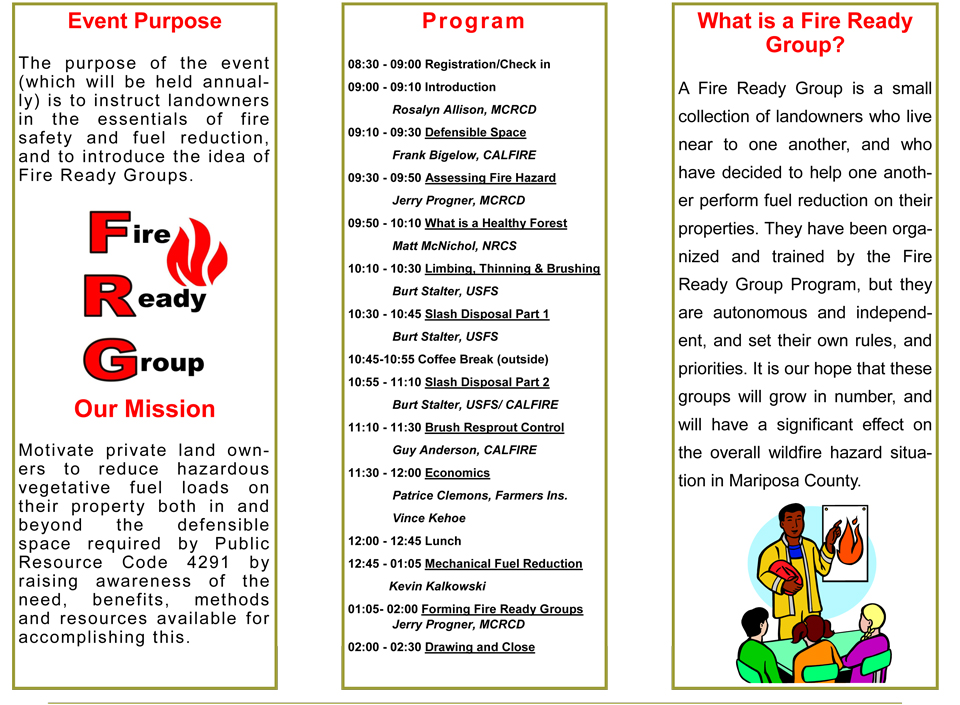The cost of performing widespread fuel reduction on private land in the Sierra foothills is daunting. If the goal is to apply fuel reduction treatments to 25% of the privately owned land in the six Central Sierra Foothill counties at a cost of $1,000 per acre, the total market value of the effort expended would equal hundreds of millions of dollars. The amount of money available through Fire Safe Councils, the counties, and state and federal agencies to support this effort is a very small fraction of that number. Given the current deficit reduction drives in Sacramento and Washington D.C., that fraction may become much smaller, especially since fuel reduction and land management on private land is our individual responsibility, not the taxpayer’s. If governments are to be of any help at all, then programs must be low in cost, but must deliver high leverage – lots of bang for the buck, and we, the landowners must assume most of the burden.
More Education
An obvious answer is a set of programs which educate us about the problem. We must begin the task of making our land resilient to fire by learning how to do landscape-level fuel reduction. As an example, a five hour fuel reduction clinic delivered to 100 or so of us who own 5 acres apiece could potentially affect 500 acres. If 25% of that land underwent fuel reduction treatment as a result of attendance at the clinic, then 125 acres would be affected. The market value of that work would be $125,000. If the cost of hosting the clinic was $2500 (a high number), then the benefit–to-cost ratio would be 50 to 1. That’s real leverage! Education can be an inexpensive way to tackle a very expensive problem, provided it is of high quality, and does not stop. Past education programs have tended to be one-shot efforts, where the effects are gone two weeks after the class or workshop.
Fire-Ready Groups
Neighbors can form groups to engage in cooperative fuel reduction at all levels. These groups are another way to support education about fire safety and fuel reduction. They can be trained in the proper use of tools and how to plan and perform fuel reduction by hand. Moreover, they can educate and reinforce one another while they are doing it. Continuous contact among members of such a neighborhood group will minimize the ‘wearing off’ effect.
Another practical effect of these neighborhood groups is that they can organize a series of mechanical fuel reduction projects on parcels that are close to one another and engage a single contractor to perform the work. In doing this they save the costs associated with transporting the equipment more than once, and the combined project may qualify for a less expensive per acre rate, rather than the more expensive per hour rate that would apply to just a few acres.
The Fuel Reduction Workshop in Mariposa County is an annual event with emphasis on the formation of Fire Ready Groups composed of neighbors willing to plan and execute fuel reduction projects in their neighborhoods
The First Annual Fuel Reduction Workshop will be held at the Midpines Community Center on October 11, 2014, beginning at 8:30am.
Seating is limited, so email MCRCD@sti.net for instructions on how to reserve a place.
Summary. We as landowners need to be constantly reminded that landscape-level fuel reduction is our responsibility. We need to be educated on the hows and whys of doing it. We need to be shown that doing it is in our best economic interest. We need to band together to get the job done. If the fuel load in the Central Sierra Foothills continues to grow without bounds, it is only a matter of time before large areas of public and private land are destroyed, with dire consequences for land values. Forest regeneration in those areas will probably not occur in our lifetime. The statistics that describe this problem may cause some to draw back because of the size of the problem. In fact, dividing the problem up in small pieces and cooperating with one another can result in significant progress. We must remember that it took seventy-five years to grow into this mess, and it will certainly take a while to fix it. The sooner we start, the better. Mother Nature is gaining on us if we do nothing.
Part One: Fire Ready Group in Mariposa County: Fire History in the Sierra Foothills
Part Two: Fire Ready Group in Mariposa County: Fire Safety and Volunteerism in the Mid-20th Century
Part Three: Fire Ready Group in Mariposa County: The Telegraph Fire Remembered
Part Four: Fire Ready Group in Mariposa County: Reducing the Fuel Load on Private Land
Part Five: Fire Ready Group in Mariposa County: The Economics of Fire Safety
Part Six: Fire Ready Group in Mariposa County: Regulations and Programs
Below is a flyer for the First Annual Fire Ready Workshop to be held in Midpines on October 11, 2014.











